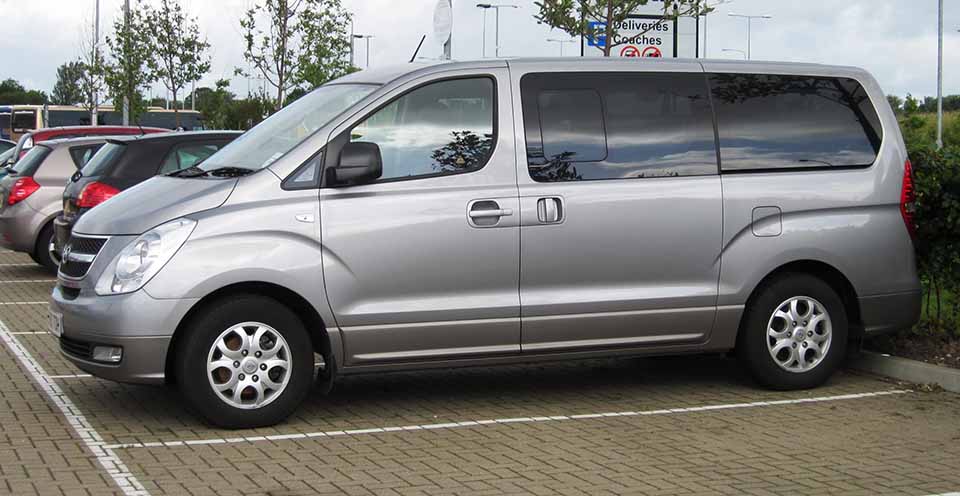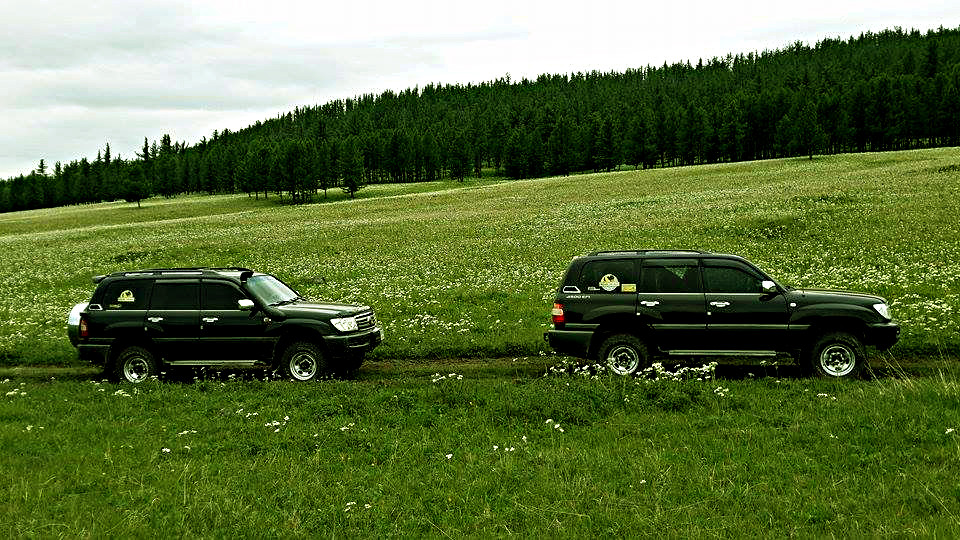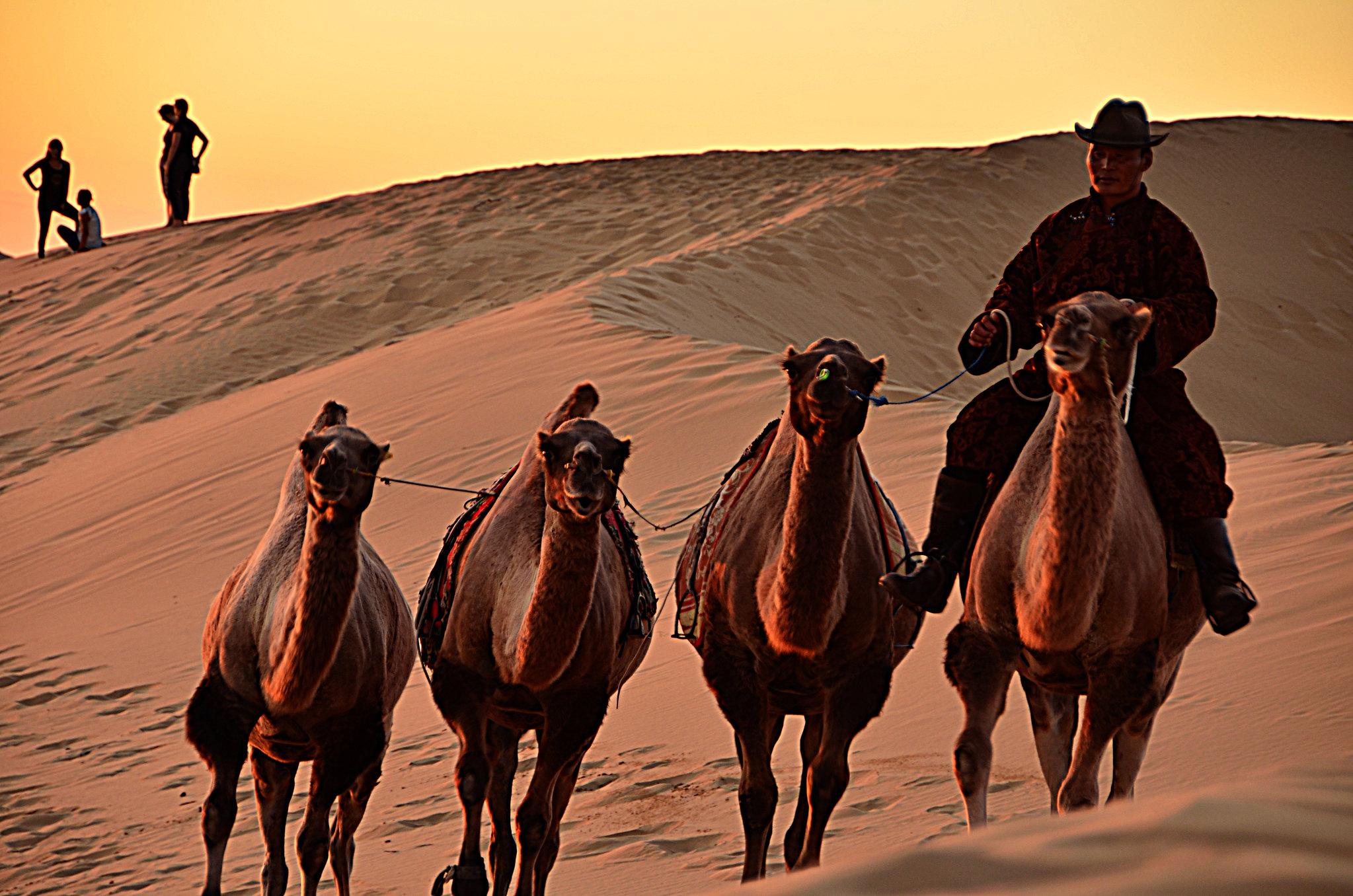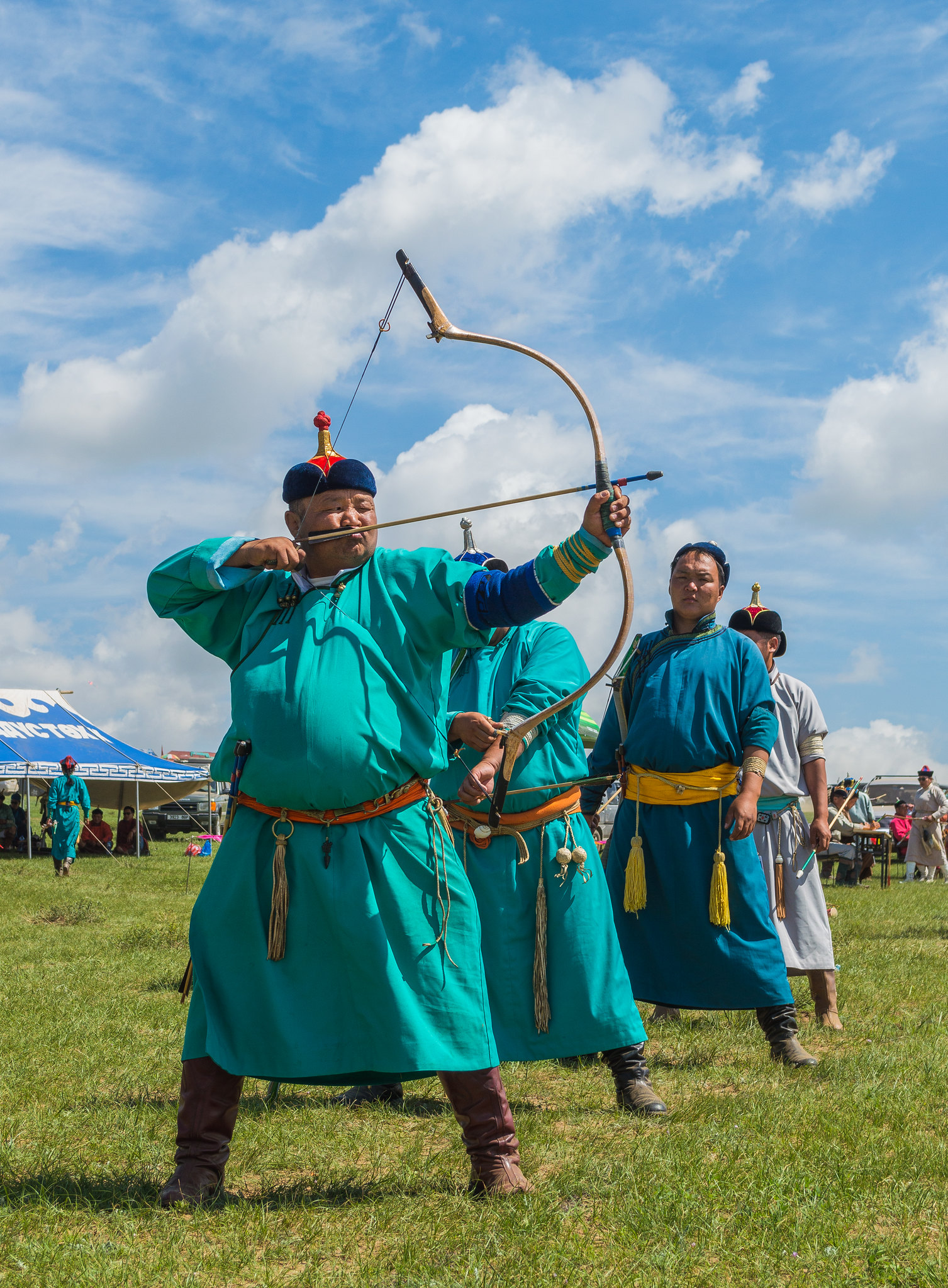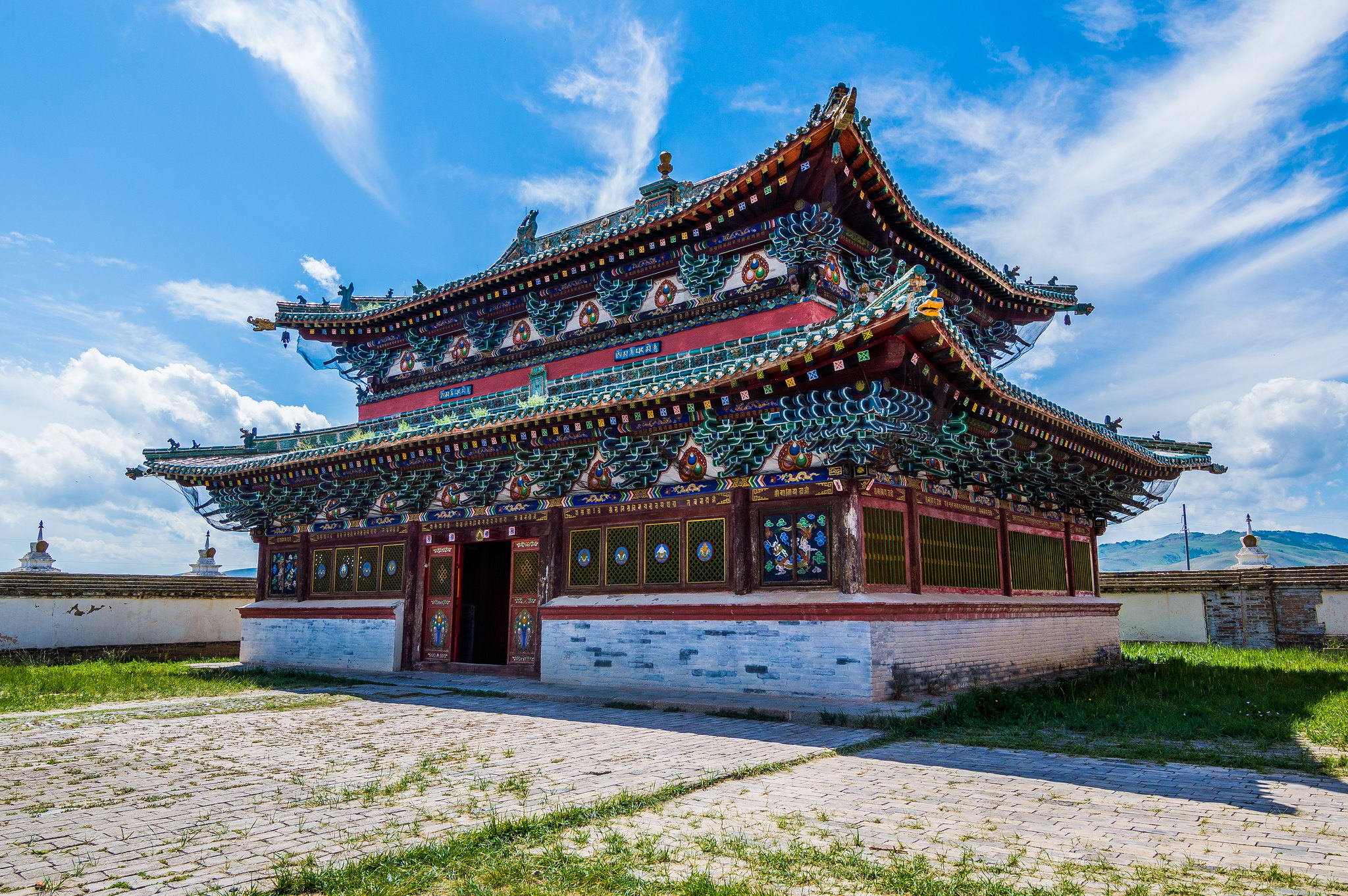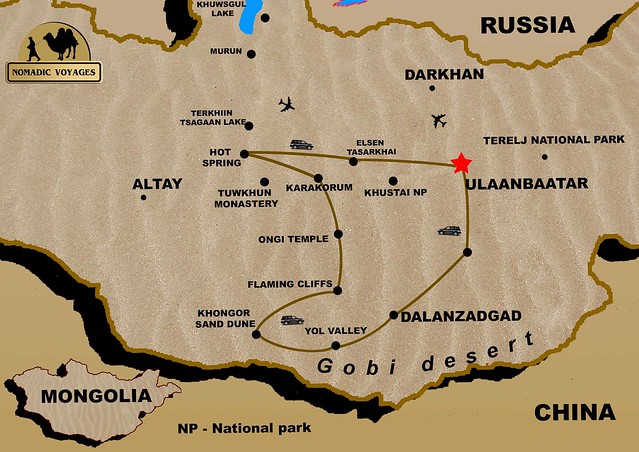Jeep Safari with Rural Naadam festival in Karakorum (15 days / 14 nights)
- Region:
- Southern & Central part of Mongolia
- Duration:
- 15 days / 14 nights
- Dates:
- July 5-18, 2024
- Note:
- You can arrange your own trip date (with best rate possible) as you request
- Number of travelers:
- Min - 2, Max - 18
Single supplement: $520
BOOK TRIP CUSTOMIZE THIS TOUR What is Ger Camp? DOWNLOAD ITINERARY AS A PDF
Quick inquiry
- The Flaming Cliffs is the legendary site where the first nest of dinosaur eggs was discovered by famous American explorer and paleontologist Roy Chapman Andrews in the 1920’s
- View the largest sand dunes in Mongolia at Khongoryn Els
- Experience a camel ride with local nomads
- Stay in local Ger camps
- Visit Karakorum was the 13th-century capital of the Mongol Empire
- Explore Gobi Gurvan Saikhan National Park
- Visit the Bogdo Khaan Winter Palace Museum. The Bogdo Khaan Winter Palace is the home of the last Mongolian King, Javzun Damba Khutagt VII.
- Visit the Hustai is the site of a unique re-introduction of Przewalski's Horse (Equus Przewalskii), called "takhi".
- Naadam Festival: Archery, Wrestling and Horse Racing
July 5 ~ Arrival in Ulaanbaatar, & Visit highlights of Ulaanbaatar
Upon arrival at Genghis Khan International Airport, you are met by our tour guide and transferred to the
hotel in the city center.
Following breakfast, we set out to explore Ulaanbaatar-the capital city of Mongolia-the home to over a
one third of the country's population where the traditional gers and Buddhist temples coexist with
sky-kissing towers! Begin from the Gandan Monastery-Mongolia's most revered religious site-home to more than
100 Buddhist monks with beautiful chapels, courtyards and a giant 75-foot gold gilded Buddha statue.
Next, we stop in the Natural History Museum that showcases the spectacular fossils found in the Gobi
desert. After lunch, we visit the National Museum of Mongolian History and culture that has rich collection
of stone and Bronze Age artifacts, costumes, sacred relics and items related to the nomadic life such as
hunting and fishing tools.
The Zaisan memorial lies in the foothills to the south of Ulan Bator (i.e. Ulaanbaatar). It was built by
the Russians as a monument to Soviet soldiers fallen in World War Two. A tiled mural lies within a huge
concrete ring, which is raised about 5 m above the ground. Zaisan is a popular tourist attraction and one of
the highlights of Ulan Bator due to the fantastic views it offers over the city. The balance of the day is
open for you to stroll the streets of the city on your own.
Overnight in 4* hotel
Meals: Breakfast, lunch & Dinner
July 6 ~ Ulaanbaatar to Elsen Tasarkhai
In the morning we will drive to Elsen Tasarkhai. In the afternoon, we will visit Erdene Khamba
Monastery, also known as Khogno Tarnyn Khiid, is located only 18 km north of Elsen Tasarhai, at the
Khogno Khan Uul Mountains (1967 m ASL.) Today there are only the ruins. Erdene Khamba
Monastery had two sections: the lower one called the Zaluu Khiid, or the Novice Temple and the upper
one called the Uvgun Khiid, or the Elders Temple, which was built on top of the mountain.
Erdene Khamba Monastery
The monastery was built in a sacred valley, according to Mongolian Buddhist traditions. Plus, the area is
very similar to Manzshir Khiid and it belongs to the Khogno Khan Natural Reserve, a protected area.
The Erdene Khamba Monastery was destroyed during Middle Age feuds between Western and Eastern
Mongolians (Dzungaria and Khalkh Mongolia) after the collapse of the Mongol Empire. The armies of
Dzungarian leader Galdan Boshigt noticed the golden roofs of the temples in Khogno Khan Mountain
and massacred the partisan-monks of the rival Zanabazar in 1640, killing them by tying their necks with
a rope (the Mongolian verb for the action is khognokh) as if they were goats and sheep. Later on, the
Soviet troops, based in Mongolia during the 1970-80s, added a few bullets to the ruins during their
outdoor trainings. The surrounding area is excellent for hiking and trekking.
Overnight in Ger Camp
Meals: Breakfast, lunch and dinner
July 7 ~ Elsen Tasarkhai to Tsenher Hot Spring
Following breakfast at tourist camp, we will drive to Tsenher hot spring. Along the way we will stop for a break in the small town of Tsetserleg to visit a monastery museum. We spend overnight in a ger camp based at natural hot springs. Soak in hot water; enjoy a hike in the hills.
Overnight in Ger Camp
Meals: Breakfast, lunch and dinner
July 8 ~ Tsenher Hot Spring to Karakorum and Rural Naadam Festival
After lunch at our camp, we head further west to Karakorum (Locally called Kharahhorin or Harhorin), the
symbolic ruins of the 13th century capital of the Mongol Empire and transfer to tourist camp.
During whole lovely day you enjoy watch Naadam festival or three manly sports such as wrestling, archery
and horse racing. Visit opening ceremony of Naadam festival. And you will see archery, wrestling and horse
racing during Naadam festival. Naadam festival is of the victory of the People’s Revolution. Mongolia
celebrates its independence and its rich cultural heritage with a festival of sports and revelry in
Ulaanbaatar. The distinctly Mongolian feel and flair of the Naadam Festival make it a wonderful spectacle, a
joyous time, and an intriguing cultural event. Colorful ceremonies and parading soldiers kick off the
celebrations. The ancient game of wrestling follows, with men competing in many rounds of competition. Both
men and women compete in the archery games, using the traditional Mongolian compound bow that terrorized
Europe when Genghis Khan and his Golden Horde moved their empire west. The quintessentially Mongolian art of
horse racing follows, where up to 800 horses compete, jockeyed by children so that the skill of the horse,
and not the rider, is tested.
Overnight in Ger Camp
Meals: Breakfast, lunch and dinner
July 9 ~ Karakorum – Erdene Zuu Monastery
In Karakorum, we will visit Erdene-Zuu, the oldest monastery, with 108 stupas, built in 1586. The monastery
was built of the remains of the ancient Mongolian capital. Ancient capital of Mongolia Karakorum city was
located on the right bank of Orkhon River and on the north-eastern slopes of the Khangai Mountain and
founded by Chinggis khan in 1220, was not only the capital of the vast Mongolian Empire but the epicenter of
trade along the Silk Road. At that time the inhabitants of city were mostly Merchants craftsmen who came to
Karakorum from all over the world. As Kublai khan moved the capital of the Mongolian Empire to China,
establishing the Yuan Dynasty, began losing its importance. In 1379 much of the city was badly damaged
during an attack by the army of the Min Dynasty.
Erdene Zuu Monastery was built by Avtai Sain Khan on the ruin of the Mongolian capital Karakorum in
1586. It was the first great Buddhist Monastery of Mongolia. It is part of the World Heritage Site entitled
Orkhon Valley Cultural Landscape. Stones from the ruins of Karakorum were used in construction. It is
surrounded by a wall featuring 108 stupas, 108 being a sacred number in Buddhism, and the number of beads in
a Buddhist rosary. The monastery was damaged by warfare in the 1680s, but was rebuilt in the 18th century
and by 1872 had a full 62 temples inside. The Erdene Zuu Monastery was taken to state protection and became
museum in 1944.
Next, we will visit the Karakorum Museum and see the Great Mongol state period, Stone Age, Bronze Age,
Ancient state period halls.
Overnight in Ger camp
Meals: Breakfast, lunch and dinner
July 10 ~ Karakorum to Ongi Temple
Today you'll drive to the ruins of the Ongi monastery. It was the largest Buddhist center in the Gobi region. There are 2 complexes of temple ruins which were built up in 1780s. During political repression in 1930s’ these two temples were destroyed and many lamas were executed and imprisoned. Visit Ruin of monastery reconstructed parts. On the way visit basin of the Ongi river which is dried out because of mining activity.
Overnight in Ger Camp
Meals: Breakfast, lunch and dinner
July 11 ~ Ongi Temple to Bayanzag (The Flaming Cliffs)
After breakfast, we leave Hongoryn Els for Bayanzag. It's a long day drive today and can take up to 5 hours but it's a scenic drive through the vast land. We will occasionally stop for photography and to watch the birds and the animals of the area. We check in our camp, wash and change and after lunch, we drive to visit the Flaming Cliff. The place was named as 'Flaming Cliffs' by Roy Chapman Andrews, an American explorer who searched throughout the Mongolian Gobi Desert and found dinosaur skeleton and eggs for the first time in Asia. The red cliff gleams with sunlight and can be seen from far away. We will take a short walk on the ridge of the cliff and look for the pieces of Dinosaur bones. We will drive little further to see the saxaul trees that contributed the name Bayanzag. Bayanzag means-rich in saxaul.
Overnight in Ger Camp
Meals: Breakfast, lunch and dinner
July 12 ~ Drive to Khongor Sand Dune
Following breakfast, we set out on our 4WD vehicle to the towering sand dunes of Hongoryn Els, which run for
60 miles alongside the Gobi-Altai Mountain range. These “Singing Sands,” which stand up to 2,500 feet, are
probably the Gobi’s most impressive sand dunes. Isolated from the rest of the country, the Singing Sands are
the best kept secret for thousand years in the history of Mongolia.
We check in our camp. After wash and change, we enjoy our lunch. After some lunch, we are transferred
to the foot of the Sand Dunes. The dunes seem to stretch on forever like a soft ribbon of sand draped over
the desert. The shifting sand blown by the wind or someone makes sound so it is called Singing Sand Dunes.
There is a beautiful green oasis known as Seruun bulag near the Khongor River. After that, we will visit a
local nomad family. We will be invited inside their ger (tent) and we will have opportunity to understand
their lifestyle. The family may welcome you to try camel’s milk and homemade cookies.
Today, approximately half of Mongolia’s population is still roaming the vast plains living in the ger
and moving their camping several times a year on the grounds with no fence. Nomadic life thrives in summer
and survives in winter. Considering climatic conditions, especially during winter, such lifestyle may seem
to the outside world to be a very hard way of living. However, Mongolians have developed for centuries such
qualities as strength and resilience that are essential for survival in this harsh nature, which is their
cherished homeland.
The family also rents out Bactrian Camels for fun ride around. Your guide can negotiate the price for
you. From here, we return to our camp and take the rest of day at leisure.
Overnight in Ger Camp
Meals: Breakfast, lunch and dinner
July 13 ~ Khongor Sand Dune to Yol Valley and Gurvansaikhan National Park
This morning we drive through vast steppe to the Gobi, Mongolia’s southernmost province of semi-arid desert.
Meet your local guide and driver and then transfer by 4WD vehicle to the Yol Valley in Gurvansaikhan
National Park, situated in the lap of Altai Mountains. On the way to our lodge, we stop to visit the local
Natural History Museum for an insight to the flora and fauna of the area.
We will take a short hike to the Yolyn Am, also called Vultures Canyon, which is a deep and narrow
gorge in the Gurvan Saikhan Mountains of southern Mongolia. The area, as part of the Gobi Desert, sees
little precipitation, is the habitat of indigenous vulture-like lammergeyers, Altai snow cocks, ibex, yaks,
and Argali mountain sheep. However, Yolyn Am is notable for a deep ice field. The ice field reaches several
meters thick by the end of winter, and is several kilometers long. In past years it remained year round, but
the modern ice field tends to disappear by September. If you do not wish to hike, you can rent a horse for
$7-8. Those who are not hiking or riding horse are requested be patient and enjoy yourself!
After visiting the canyon, you are transferred to the camp and rest of the day is open for rest.
Overnight in Ger camp
Meals: Breakfast, lunch and dinner
July 14 ~ Day trip to Khavtsgait Petroglyphs and Nomads day
In the morning we drive to the site of the Khavtsgait Petroglyphs. The Khavtsgait Petroglyphs from the Bronze
Age (4000-3000 BC) are beautifully carved on many rocks on the top of a sacred mountain. It is easy to find
the rock paintings there because they are spread on rocks all around. The area is very rocky and can be
slippery to climb, but by carefully following a path up the mountain, you can reach the top to see these
beautiful rock paintings.
The petroglyphs were carved and painted with motifs consisting of animals, hunting scenes and weapons.
They depict various animals related to everyday life of ancient people including deer, bears, wolves and
hunters, and wolves with livestock. Other paintings depict more domestic scenes of yaks pulling carts, the
wheels and horses flattened sideways like hieroglyphs, and herders on horseback. The engravings vary in
size, ranging from two-centimeters to the real life size of horses.
After the rest, we will visit a herder family nearby. We will spend some time there getting to know the
family members and their casual yet unique daily lifestyle. It is a good chance to see how the family
members cooperate together to do their daily even hourly chores such as milking mares, fencing and milking
the goats. If you wish, you are welcome to try some mare's fermented milk and other dairy products.
Overnight in Ger camp
Meals: Breakfast, lunch and dinner
July 15 ~ Yol Valley to Baga Gazriin Chuluu
Drive to Middle Gobi is known as Baga Gazriin chuluu (earth stone). You will be reached in the early afternoon, lunch at the camp. There are some interesting granite rock formations, also there eye spa which supposed to be good for sights. There is ruin of ancient small temple, located middle of the rock.
Overnight in Ger camp
Meals: Breakfast, lunch and dinner
July 16 ~ Baga Gazriin Chuluu to Terelj National Park
Following morning breakfast, we drive Gorkhi Terelj National Park. This unforgettable excursion will take you
to features such as scenic valleys, a winding river, and restful groves of trees. Many nomads live in the
park itself, where they find lush land for their animals, and you may even see majestic herds of yak grazing
near the camp. Once inside the park you will be able to visit the notable rock formations "Turtle rock" and
“Monk reading a book." You will also have the opportunity to hike up to the Aryabal meditation center and
learn more about Mongolian Buddhism.
On the way to the national park, you will take a detour to visit the giant Statue of Chinggis Khan which
stands 40m (132 ft) high. The monument is about 33 miles east of Ulaanbaatar and stands at the point where,
according to legend, he found a golden whip. The statue is symbolically pointed east, towards his
birthplace. It is on top of the Chinggis Khan Statue Complex, a visitor center, itself 10 meters (32 ft 10
in) tall, with 36 columns representing the 36 khans from Genghis to Ligdan Khan. It was designed by sculptor
D. Erdenebileg and architect J. Enkhjargal and erected in 2008.
Overnight in Ger camp
Meals: Breakfast, lunch and dinner
July 17 ~ Terelj National Park to Ulaanbaatar
On your drive back to Ulaan Baatar, visit the Bogdo Khaan Winter Palace Museum. The Bogdo Khaan Winter Palace is the home of the last Mongolian King, Javzun Damba Khutagt VII. The museum contains a number of Buddhist artworks and the private collection of Bogdo Khaan, composed of gifts from rulers and kings from all over the world. The artworks displayed here were made by the top Mongolian, Tibetan, and Chinese master- sculptors of the 18th and 19th centuries and represent the gods of Buddhist pantheon. If you did not have time on your earlier trip through Ulaan Baatar, visit the Museum of National History.
Overnight in 4* hotel
Meals: Breakfast, lunch and dinner
Single supplement: $520
| Included | Not included |
| A local Mongolian guide who will escort the group throughout your tour. | International airfare |
| All meals as listed in itinerary | Travel insurance |
| Staying Tourist camp | Beverages |
| Sightseeing as per itinerary | Optional activity cost |
| Accommodation in 4 stars hotel in Ulaanbaatar (twin standard room double occupancy) | Excess baggage charge |
| Transportations by 4WD vehicles | Single room supplement |
| Transfers between the airport and hotel | Any additional things which are not mentioned above |
| Daily supply of bottled water | |
| Tours per the itinerary including entrance fees | |
| Cultural Show |
All airport transfers and sightseeing will be by private cars, SUVs and mini bus. The arrival and departure transfers will be by Sedan Cars which are usually Japanese made Toyota or Honda cars. Sightseeing within Ulaanbaatar will be by an air conditioned minibus. Outside Ulaanbaatar, we provide 4WD Land cruisers or SUVs. There will be 3 to 4 travelers seated in a 4WD vehicle.

